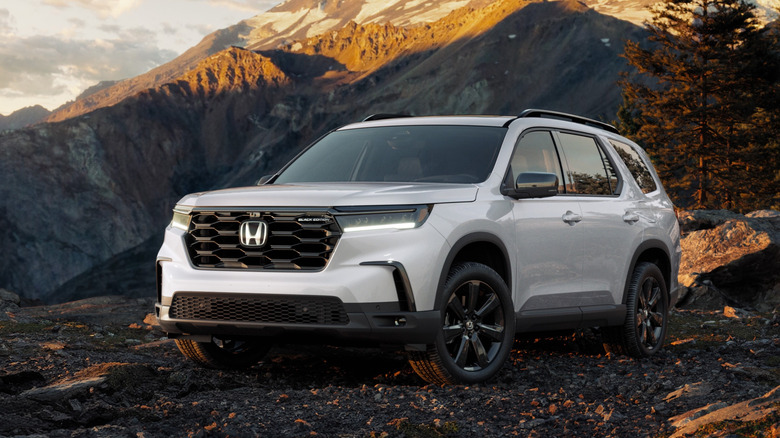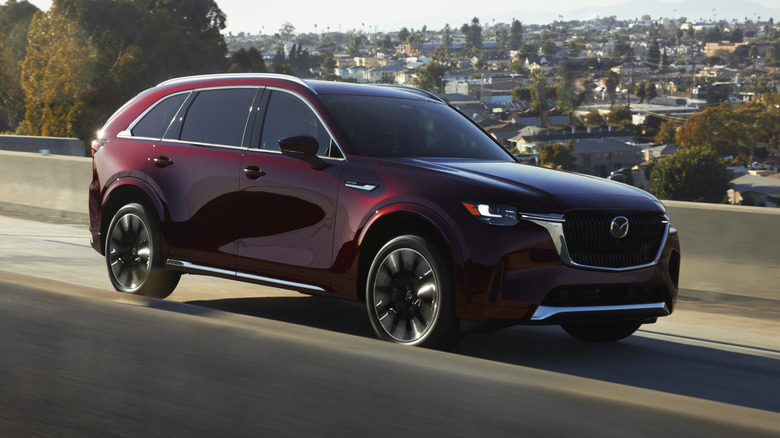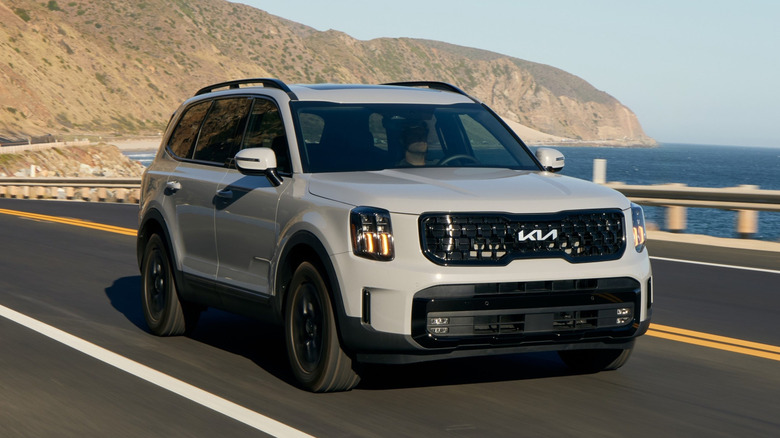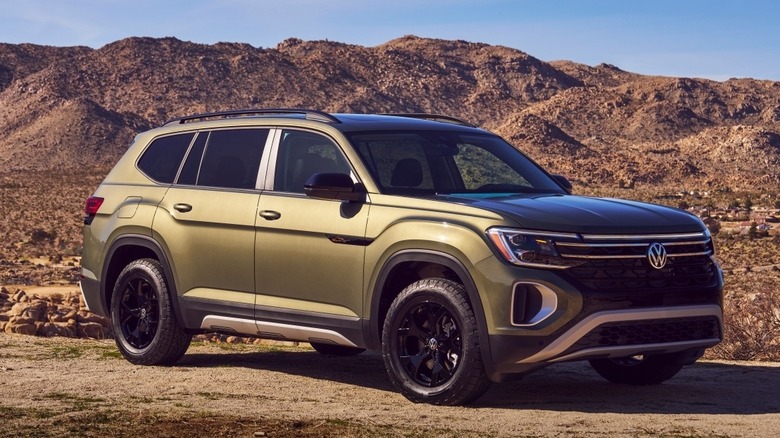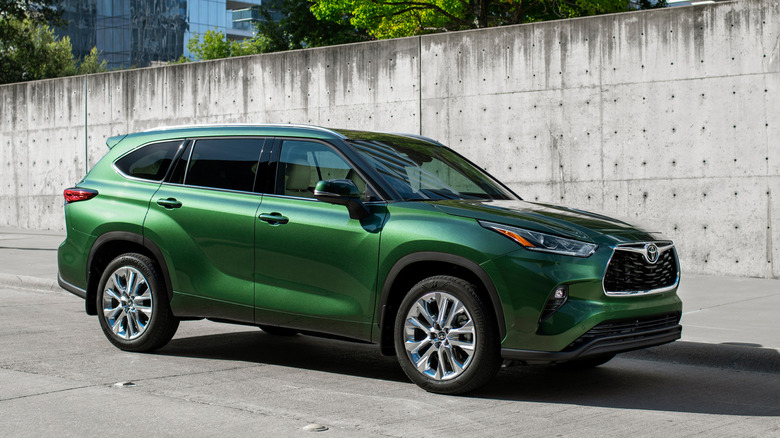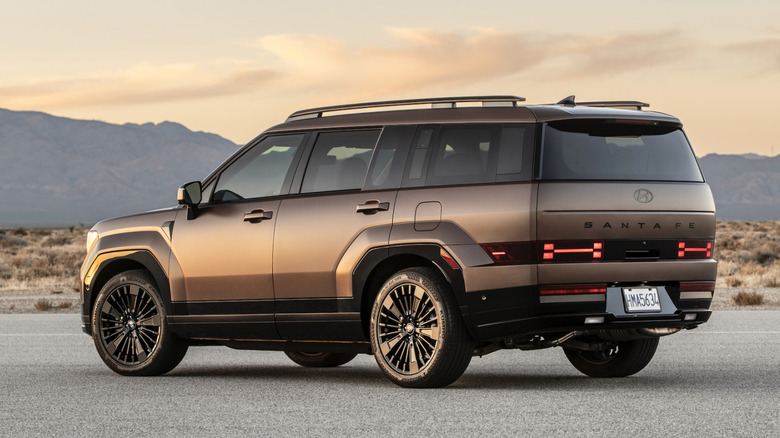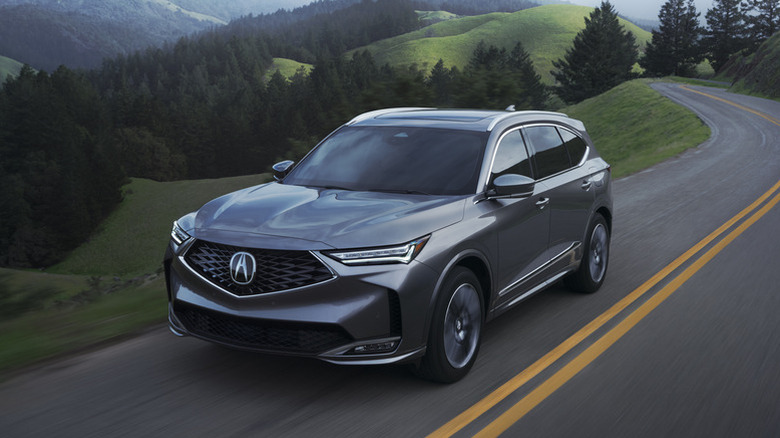6 Alternatives To The Honda Pilot To Consider Before You Buy
Factors like safety, pricing, fuel economy, comfort, and space all contribute to the decision of which SUV to buy. Thankfully, the Honda Pilot has all those bases covered — and then some. The Pilot is a comfortable and well-equipped choice amongst three-row SUVs and it's a safe choice for growing families. The Pilot's price ranges between $41,595 and $55,975 (depending on equipment), which is competitive for the class. It's also rated a Top Safety Pick+ (the highest possible rating) from the IIHS (Insurance Institute for Highway Safety), and it received 5 stars (out of 5 possible) from NHTSA (National Highway Traffic Safety Administration) for overall crash safety.
The Pilot also comes with a 3.5-liter V6 that puts out 285 horsepower and 262 lb-ft of torque, with available all-wheel drive and fuel economy ratings that fall between 20 and 22 mpg combined, depending on which trim level you go with — both of which are decent power numbers and fuel economy ratings for the class. On the inside, there's lots of room for passengers and cargo. The Pilot seats as many as eight passengers and has as much as 22.4 cubic feet of storage space behind the third row and up to 113.7 cubic feet of storage with the first and second row folded flat. So, the Pilot is spacious, efficient, and safe, but how does it stack up against other three-row SUVs? We put together a list of some of the Pilot's top rivals to find out.
Mazda CX-90: Upscale, efficient, and powerful
The area where the Mazda CX-90 excels is in its overall refinement. One of the sleekest and most fashion-forward SUVs in its class, the CX-90 is priced between $39,300 (including destination) and $57,905. In our test drive of the 2024 CX-90, we found the interior to be one of the best in class. It also provided an excellent driving experience from behind the wheel — combine those two things and it feels seriously upscale.
The CX-90 has a few different powertrains to choose from, all with plenty of grunt. The CX-90's standard turbocharged 3.3-liter inline-six is paired with a mild-hybrid battery and puts out 280 horsepower and 332 lb-ft of torque. On Turbo S models, power goes up as high as 340 horsepower. Meanwhile, an available version of the CX-90 with a plug-in hybrid powertrain puts out as much as 323 hp.
For efficiency, the CX-90 has the Pilot beat. The EPA gives it a combined rating of 25 mpg combined with the six-cylinder engine. The plug-in hybrid (PHEV) CX-90 hasn't been officially rated yet, but it has the potential to be even more efficient. The CX-90 is also a Top Safety Pick+ according to the IIHS, with a 5-star overall rating from NHTSA. Where the Mazda does fall behind, though, is cargo space. Behind the third row, it only has 14.9 cubic feet of space and with both rear rows folded, it tops out at 74.2 cubic feet.
Kia Telluride: Well-equipped and refined
The Telluride is a respectable choice amongst three-row SUVs with lots of space for passengers and cargo. During our test of the Kia Telluride, we found it roomy, comfortable, and filled with lots of tech that punches above its class. The upscale interior is a particular benefit, especially on top trim levels. Depending on which trim level you go with, the Telluride ranges from $37,585 (including $1,395 destination fee) to $53,780 — with most trims representing a small savings against comparable Pilot trims.
Under the hood, the Telluride gets a 3.8-liter V6 that produces 291 horsepower and 262 lb-ft — nearly an exact match for the Pilot. And when it comes to fuel economy, the Telluride and the Pilot are basically even too. Front-wheel drive Tellurides are rated at 22 mpg combined, while all-wheel drive models check in at 20 mpg combined. This isn't a win or a loss for either of these two big SUVs, but more of a tie for second. Neither the Telluride or the Pilot is offered as a hybrid or with an optional more-efficient engine.
Behind the third row, the Telluride offers 21 cubic feet of cargo space and 87 cubic feet of space with the second and third row folded. It also has enough legroom in both the second and third row to accommodate adults. Like the Pilot and the CX-90, the Telluride gets top safety scores from the IIHS and NHTSA – Top Safety Pick+ and 5 stars overall, respectively.
Volkswagen Atlas: A new engine adds some appeal
With strong styling and a big road presence, the Atlas feels less like a family crossover and more like a traditional big-bruiser SUV. Fortunately, looks can be deceiving as the Atlas is quite comfortable and accommodating, offering 20.6 cubic feet of cargo space behind the third row and 96.6 cubic feet with the rear rows folded. There is the drawback of the Atlas only offering seating for seven passengers, while most rivals offer seating for eight, but if you can get over that hurdle, it's an appealing SUV. Prices for the Atlas start at $39,625 (including $1,425 destination fee) and make their way up to $55,085 on top trim levels before adding options.
For 2025, the Atlas received a new turbocharged four-cylinder engine that produces 269 horsepower and 273 lb-ft of torque — a small increase over the previous engine of 34 horsepower and 15 lb-ft of torque. That's a healthy amount for the class, but it is unlikely to provide thrilling acceleration.
The various trim levels of the Atlas differ in their overall fuel economy, ranging from 23 mpg combined on the high end down to 20 mpg combined on the low end, making the Atlas and Pilot pretty evenly matched when it comes to efficiency. The Atlas gets the distinction of Top Safety Pick from the IIHS (just below the highest-possible Top Safety Pick+) which is common for a number of SUVs on this list. It's also earned 5 stars for overall crash test safety from NHTSA.
Toyota Highlander: Hybrid fuel economy has entered the chat
The 2025 Toyota Highlander (like most Toyotas today) is available with a standard powertrain and a hybrid. That gives it a big advantage over the Pilot and other three-row SUVs when it comes to fuel economy. The standard Highlander is powered by a turbocharged 2.4-liter four-cylinder engine that produces 265 horsepower and 310 lb-ft of torque. The hybrid uses a 2.5-liter four-cylinder engine and a hybrid system for 243 horsepower. Even on non-hybrid versions, the Highlander has impressive fuel economy at either 24 or 25 mpg combined. Hybrid models are rated as high as 36 mpg combined – a very impressive number for the class and much more than the Pilot has to offer.
Prices for the Highlander range from $40,970 (including $1,450 destination fee) to $55,125 before options. A pricier (but more upscale version) of the Highlander is also available, called the Grand Highlander. It offers a bit of luxury for the price, but the standard Highlander is pretty appealing on its own.
On both the standard and hybrid versions of the Highlander, there are some compromises for this increase in fuel economy though. Cargo space is just 16 cubic feet behind the third row and 84.3 cubic feet with both rear rows folded — much less than the Pilot. It also isn't quite as highly rated by safety agencies as the Pilot, but the Highlander does get the IIHS's laudable status as a Top Safety Pick and a 5-star overall rating from NHTSA.
Hyundai Santa Fe: More hybrid efficiency
Made from many 90-degree angles and lots of rectangular panels, the newest Hyundai Santa Fe has styling that will certainly stand out in a crowd. The exterior is mostly a love-it-or-hate-it proposition (I happen to really enjoy the styling) but the interior is much less polarizing. The Santa Fe's cabin is well laid out, with easy-to-understand controls and lots of high-quality materials. Pricing is very competitive amongst three-row rivals, with the base-trim Santa Fe starting as low as $35,365 (including $1,415 destination fee) and topped-out hybrid models starting at $50,215 before options. Cargo space is slightly limited, with just 14.6 cubic feet of storage behind the third row of seats and 79.6 cubic feet of storage behind the first row, but the Santa Fe makes up for it at the pump.
Standard versions of the Santa Fe are powered by a turbocharged 2.5-liter four-cylinder engine that makes 277 horsepower and 311 lb-ft of torque. The hybrid uses a turbocharged 1.6-liter four-cylinder and has a combined rating of 231 horsepower and 271 lb-ft of torque. Like the Highlander, the Santa Fe's hybrid trim earns it big points in the fuel-economy department. Standard models range from 22 mpg combined to 24 mpg combined, but the hybrid is somewhere between 34 and 36 mpg combined. The current generation of the Santa Fe has not yet been rated by NHTSA for safety, but the IIHS does give it Top Safety Pick status, slightly below the Pilot.
Acura MDX: Upping the luxury quotient
If you like the Honda Pilot but you want more luxury equipment, the MDX could be the right choice for you. The MDX shares some of its underpinnings with the Pilot, but it offers a much more upscale experience and an optional high-performance variant. The standard MDX is powered by a 3.5-liter V6 that makes 290 horsepower and 267 lb-ft of torque while the MDX Type S uses a turbocharged V6 that makes 355 horsepower and 354 lb-ft of torque. The Type S is certainly sportier and more fun to drive, but it makes you pay the price when it comes to efficiency.
The high-performance MDX Type S checks in at 19 mpg combined, but the standard model is better at the pump: 21 mpg combined on all-wheel drive models and 22 mpg combined on front-wheel drive models. There's a decent amount of space in the MDX, with as much as 18.1 cubic feet of storage behind the rear seats and 95 cubic feet with both the second and third row folded flat. Getting into the third row is relatively easy too, making the transportation of adults a breeze.
Like its Honda sibling, the MDX is rated a Top Safety Pick+ by the IIHS, and it received 5 stars overall from NHTSA. And as you'd probably expect, the MDX is significantly more expensive than the Pilot, ranging from $52,250 (including destination) on the low end, all the way up to $76,300 with the Type S.
